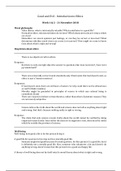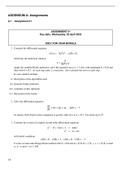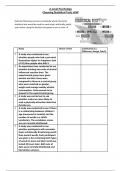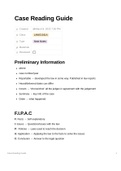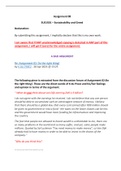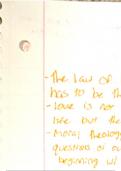LECTURES
& CHAPTERS
System theory – 2023
,TABLE OF CONTENT
WEEK 1......................................................................................................................................3
Lecture 1 – Introduction into Systems Theory........................................................................3
Chapter 1 – introducing organizations as social systems conducting experiments................5
WEEK 2......................................................................................................................................9
Lecture 2 – Classical Systems Theory Part 1..........................................................................9
Chapter 2 – the experimental arche: Ashby’s Cybernetics...................................................14
WEEK 3....................................................................................................................................19
Lecture 3 – General Systems Theory Part 2..........................................................................19
Chapter 3 - the experimental arche continued: von Foerster on observing systems.............22
WEEK 4....................................................................................................................................24
Lecture 4 – Organizations as Social Systems; Luhmann (MISSED)....................................24
Chapter 4 – the social “arche” organizations as social systems: Luhmann..........................28
WEEK 5....................................................................................................................................36
Lecture 5 – Functional design principles: the viable system model.....................................36
Chapter 6 – Beer: functional design principles for viable infrastructures............................40
WEEK 6....................................................................................................................................45
Lecture 6 – Specific design principles: designing organizational structures........................45
Chapter 7 – specific design principles: de Sitter’s organizational structures........................50
WEEK 7....................................................................................................................................57
Lecture 7 – Systems theory and human resources................................................................57
Chapter 9 - Poor survival, disciplining organizational behavior...........................................59
Terms glossary..........................................................................................................................64
,WEEK 1
Lecture 1 – Introduction into Systems Theory
1) System: “ a concrete unity that consists
of elements and relations between those
elements which shows behavior.”
Behavior can be thought of in (example of Plank Selling Department);
1) Behavior in terms of activities (transformation process)
- Information transformation outcome
2) Behavior in terms of effects of these activities
- Direct output
- Indirect output; employees working there
having an amount of satisfaction – you cannot
see it directly in the output.
3) Behavior in terms of variables and values
- You look for variables that describe the effect
of the behavior.
o Quantity; number of planks sawed per week (direct)
o Quality (direct)
o Employee satisfaction (indirect)
Behavior: “the sequence of values of the variables that you used to describe the effect of the
behaviors”. There is a variety of variables that you can look at and of which you can describe
behavior of a system.
Concrete unity (in organizations)
a. Elements
i. Human Resources
ii. Technology; all the other resources next to HR.
b. Relations between those elements
i. Structure: the way tasks are defined and related to each other. A task
says that HR has to do something (activities) with an effect using
different tools (technology). Structure is the way to relate HR and
technology.
2) Desired behavior
, To mark a difference between desired and undesired behavior, you need a norm value. If the
behavior falls between the norm value, it is desired. If it falls outside the norm value, it is
undesired.
3) Disturbances
Whenever there is undesired behavior, a disturbance has occurred. It is a cause for undesired
behavior.
4) Regulation
Making sure that a system shows desired behavior despite disturbances (machines that break
once in a while for instance). In order to regulate, you have to think of actions: (1) define the
actions and (2) perform the actions. Regulating is dealing with complexity.
Recipe for regulation
i. Define the system that we are going to regulate. It can be done with the example of
a person having a bath.
a. Concrete system: describe the concrete unity by defining the elements and
relations. It is the concrete unity consisting of elements and relations that show
behavior. The element is the person having a bath, but also the bath by itself
for example.
b. Abstract system: the set of variables that you use to describe desired behavior.
In the example of the bath tub, the variables can be the water level or the
temperature for instance.
ii. Define desired behavior: think of norm values.
iii. Determine disturbances: what could be a cause for undesired behavior.
iv. Think of regulatory actions: define them and carry them out when necessary. This
is about making sure the water temperature for instance, comes to the desired
value. Let go of cold water, and put some new hot water in the tub. You can also
have pro-active regulations: regulations before the disturbance actually happened.
The regulatory action needs to relate to the disturbance.
The idea of complexity is measured in terms of variety. Variety is the number of different
items of a set of items. The more complex the disturbances, the harder it will be to deal with
these disturbances and regulate the transformation process. Therefore, you also need a certain
degree of complexity in regulatory actions: this is positive complexity. While complexity in
disturbances is negative complexity. If you have a set of (A, 1, 3), the variety is three.
Law of requisite variety
- The idea of a transformation process is to have a desired effect. However, it can be
that the system shows undesired behavior. The values are outside the norms. The
cause can be that there are disturbances. These can be called a set of disturbances.
The more complex the set, the harder it is for the system to show desired behavior
(there are more events that trigger undesired behavior). The complexity is negative.
& CHAPTERS
System theory – 2023
,TABLE OF CONTENT
WEEK 1......................................................................................................................................3
Lecture 1 – Introduction into Systems Theory........................................................................3
Chapter 1 – introducing organizations as social systems conducting experiments................5
WEEK 2......................................................................................................................................9
Lecture 2 – Classical Systems Theory Part 1..........................................................................9
Chapter 2 – the experimental arche: Ashby’s Cybernetics...................................................14
WEEK 3....................................................................................................................................19
Lecture 3 – General Systems Theory Part 2..........................................................................19
Chapter 3 - the experimental arche continued: von Foerster on observing systems.............22
WEEK 4....................................................................................................................................24
Lecture 4 – Organizations as Social Systems; Luhmann (MISSED)....................................24
Chapter 4 – the social “arche” organizations as social systems: Luhmann..........................28
WEEK 5....................................................................................................................................36
Lecture 5 – Functional design principles: the viable system model.....................................36
Chapter 6 – Beer: functional design principles for viable infrastructures............................40
WEEK 6....................................................................................................................................45
Lecture 6 – Specific design principles: designing organizational structures........................45
Chapter 7 – specific design principles: de Sitter’s organizational structures........................50
WEEK 7....................................................................................................................................57
Lecture 7 – Systems theory and human resources................................................................57
Chapter 9 - Poor survival, disciplining organizational behavior...........................................59
Terms glossary..........................................................................................................................64
,WEEK 1
Lecture 1 – Introduction into Systems Theory
1) System: “ a concrete unity that consists
of elements and relations between those
elements which shows behavior.”
Behavior can be thought of in (example of Plank Selling Department);
1) Behavior in terms of activities (transformation process)
- Information transformation outcome
2) Behavior in terms of effects of these activities
- Direct output
- Indirect output; employees working there
having an amount of satisfaction – you cannot
see it directly in the output.
3) Behavior in terms of variables and values
- You look for variables that describe the effect
of the behavior.
o Quantity; number of planks sawed per week (direct)
o Quality (direct)
o Employee satisfaction (indirect)
Behavior: “the sequence of values of the variables that you used to describe the effect of the
behaviors”. There is a variety of variables that you can look at and of which you can describe
behavior of a system.
Concrete unity (in organizations)
a. Elements
i. Human Resources
ii. Technology; all the other resources next to HR.
b. Relations between those elements
i. Structure: the way tasks are defined and related to each other. A task
says that HR has to do something (activities) with an effect using
different tools (technology). Structure is the way to relate HR and
technology.
2) Desired behavior
, To mark a difference between desired and undesired behavior, you need a norm value. If the
behavior falls between the norm value, it is desired. If it falls outside the norm value, it is
undesired.
3) Disturbances
Whenever there is undesired behavior, a disturbance has occurred. It is a cause for undesired
behavior.
4) Regulation
Making sure that a system shows desired behavior despite disturbances (machines that break
once in a while for instance). In order to regulate, you have to think of actions: (1) define the
actions and (2) perform the actions. Regulating is dealing with complexity.
Recipe for regulation
i. Define the system that we are going to regulate. It can be done with the example of
a person having a bath.
a. Concrete system: describe the concrete unity by defining the elements and
relations. It is the concrete unity consisting of elements and relations that show
behavior. The element is the person having a bath, but also the bath by itself
for example.
b. Abstract system: the set of variables that you use to describe desired behavior.
In the example of the bath tub, the variables can be the water level or the
temperature for instance.
ii. Define desired behavior: think of norm values.
iii. Determine disturbances: what could be a cause for undesired behavior.
iv. Think of regulatory actions: define them and carry them out when necessary. This
is about making sure the water temperature for instance, comes to the desired
value. Let go of cold water, and put some new hot water in the tub. You can also
have pro-active regulations: regulations before the disturbance actually happened.
The regulatory action needs to relate to the disturbance.
The idea of complexity is measured in terms of variety. Variety is the number of different
items of a set of items. The more complex the disturbances, the harder it will be to deal with
these disturbances and regulate the transformation process. Therefore, you also need a certain
degree of complexity in regulatory actions: this is positive complexity. While complexity in
disturbances is negative complexity. If you have a set of (A, 1, 3), the variety is three.
Law of requisite variety
- The idea of a transformation process is to have a desired effect. However, it can be
that the system shows undesired behavior. The values are outside the norms. The
cause can be that there are disturbances. These can be called a set of disturbances.
The more complex the set, the harder it is for the system to show desired behavior
(there are more events that trigger undesired behavior). The complexity is negative.


